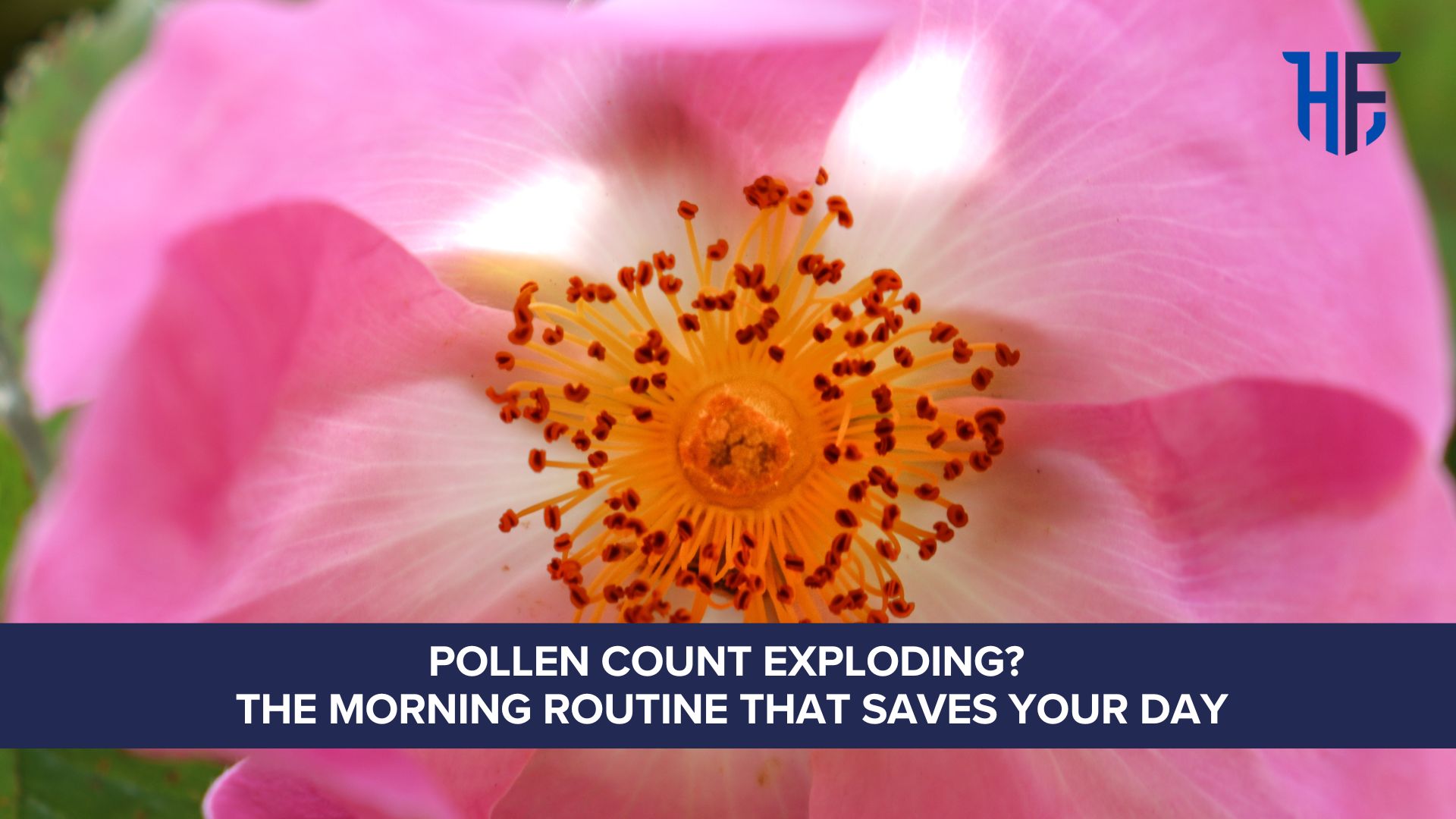High pollen day on the forecast and symptoms already brewing? A calm morning routine can block pollen before it hits your nose. Five quick steps set up clear breathing and steady eyes. Simple tools, smart timing, and tiny tweaks do the heavy lifting. Start strong, and the rest of the day feels easier.
What should be checked before getting out of bed?
The pollen forecast should be checked, windows should be kept shut during peak hours, and today’s medicine timing should be confirmed. A plan for a shower and clean clothes should be set if counts are high. A saline spray, tissues, and eye drops should be within reach for quick use. Bedding should be kept separate from yesterday’s outdoor clothes to avoid contamination. With checks done, prepare the bedroom to work for you.
How should the bedroom be prepared on high-pollen mornings?
Windows should be closed at dawn, and a HEPA air filter should run if available. Pillowcases should be changed more often in season to cut pollen build-up around the face. Hair should be tied or covered at night after heavy outdoor time. Outdoor coats and bags should stay outside the bedroom to protect the sleeping space. With the room ready, move to a short nose and eye routine.
What should go into a two-minute nasal and eye routine?
A gentle saline rinse should be done first to wash out pollen and thin mucus. A steroid nasal spray should be used with the correct technique aimed away from the septum. A non-drowsy antihistamine should be taken if part of your plan for the day. Lubricant or antihistamine eye drops should be used if the eyes itch or stream. With symptoms calmer, set up breakfast and clothing.
What should be eaten or drunk to set up a calmer morning?
Water should be sipped early to thin secretions and soothe the throat. Breakfast should be simple to avoid extra nasal drip and coughing. A warm drink can add mild steam that helps clear the nose. Fresh clothes should go on after eating so kitchen vapour does not trap pollen in fabric. With the body set, get ready to step outside.
What should be done before stepping outside?
A brimmed hat should be used to reduce pollen falling onto hair and face. Wraparound glasses should be worn to shield eyes from wind-borne pollen. A light mask can help on very hot days or near grass cutting. A thin layer of balm can be dabbed around the nostrils to trap particles. With barriers in place, leave home without bringing pollen along.
How can pollen be kept from travelling out the door with you?
Outdoor jackets and bags should be kept by the door, not on beds or sofas. Shoes should be left at the entrance so pollen does not spread through the home. A quick lint-roller pass on sleeves can lift settled grains before you go. Pets should be kept out of the bedroom, especially after walks. With the exit clean, choose a lower-exposure commute.
What transport and commute tweaks reduce exposure?
Side streets should be picked where possible to avoid turbulence that lifts pollen. Car windows should stay closed, and the system should run on recirculate during peaks. A scarf or mask can help at bus stops on windy mornings. Cycle routes under blossom should be avoided in peak weeks. With arrival near, plan a quick reset at the destination.
What should be done on arrival at work or school?
Hands and face should be washed to remove pollen and calm skin. Eyelids can be wiped gently with a clean tissue if drops are not at hand. A brief saline mist can refresh the nose without a full rinse. Outdoor layers should hang away from desks and seats to stop the spread. With the morning settled, manage exercise with care.
How can exercise be managed on high-pollen days?
Exercise should move to late afternoon or evening when levels can drop. Indoor training should be chosen on extreme days to protect the airway. A pre-exercise rinse and drops can lower irritation during effort. A cool-down shower should follow to remove pollen from skin and hair. With activity planned, carry a small kit for the day.
What should be carried in a small allergy kit?
A compact kit should include tissues, saline spray, eye drops, a non-drowsy antihistamine, and a spare mask. Hand gel should be added for quick clean-ups after touching rails or seats. A zip bag keeps items tidy and easy to find when symptoms flare. Contact lens users should add glasses for high-pollen emergencies. With tools ready, use medicines wisely and on time.
When should medicines be used, and when should repeats be avoided?
Daily antihistamines should be taken at the same time each day if advised. Steroid nasal sprays should be used as directed rather than in random bursts. Double-dosing should be avoided unless a clinician has agreed to it. The technique should be checked so that each spray or drop has a full effect. With dosing steady, adjust the routine for special groups.
How should the routine be adjusted for kids, contact lens users, or pregnancy?
For kids, doses should match age guidance, and a bedtime shower should follow outdoor play. Contact lens users should switch to glasses on very high days to reduce eye irritation. In pregnancy, non-drug steps and clinician-approved sprays should be used with care. School bags should carry tissues and eye drops where allowed. With variations covered, know the signs that need advice.
When is it time to seek medical advice, and what red flags matter?
Advice should be sought if symptoms persist most days, disturb sleep, or limit work or driving despite routine steps. Wheeze, chest tightness, or breathlessness should be treated as urgent red flags. Severe eye pain, light sensitivity, or vision change should be reviewed quickly. Recurrent sinus pain or fever suggests another cause and needs assessment. With timing clear, same-day support can help.
Can telemedicine help you get a same-day plan without leaving home?
Telemedicine can help by reviewing symptoms, checking technique, and adjusting doses on the same day. Photos of eye redness and a short symptom diary can be shared for clarity. A clinician can advise on testing or immunotherapy where suitable. Follow-ups keep the plan aligned as the season changes. With remote help available, a little preparation makes calls smoother.
How do you prepare for a consultation with Hay Fever Treatment, and what will be covered?
Preparation should include a two-week diary, a list of medicines used, and notes on pollen levels and triggers. The consultation will cover symptom patterns, dosing schedules, and correct spray and eye-drop technique. Options such as allergy testing and immunotherapy will be discussed where appropriate. Lifestyle and management strategies will be tailored to morning and commute needs. With preparation complete, choosing a provider becomes straightforward.
Why choose Hay Fever Treatment for assessment, testing, and a personalised plan?
Hay Fever Treatment should be chosen because comprehensive assessments, evidence-based allergy testing, and personalised treatment plans are provided. Immunotherapy is available where indicated, and technique coaching is offered for real-world results. Lifestyle guidance focuses on morning and travel routines that genuinely cut exposure. Telemedicine services make same-day support easy during peak weeks. With expert help close by, finish with a simple daily plan.
A Simple Morning Plan That Keeps Symptoms Low
A calmer day starts with a quick pollen check, a saline rinse, correct nasal spray use, and wraparound glasses. A shower and clean clothes stop old pollen from riding along to work or school. Closed car windows, recirculate, and a small allergy kit keep the commute steady and predictable. Hand and face washes on arrival reset exposure and make the afternoon easier. With consistent morning habits and a clear plan, high-pollen days stay manageable from the moment the alarm rings.





